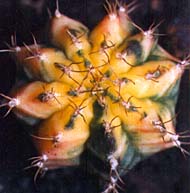Cultivars: your own description
CULTIVAR'S CLASSIFICATION BY STEM COLOR
by Nikolay Shemorakov (narrated by Valery Kalishev)
"If you are guided only by visual observations and don't consider development of mutations in cells then, in my opinion, the classification of mutants with pigment anomalies developed by Estonian scientists (Kalam Y., Orav T., 1974) is quite appropriate for cacti and other succulents despite the fact that it was developed for leaf plants. All we need is minor adaptation and addendum to their works.
My version is not very novel, it even contradicts to their work in fewplaces."
This introduction was written by Nikolay Shemorakov for his article. He provided detailed description of whole color spectrum of cacti and other succulents and divided all cultivars into groups. Considering complexity of material I've tried to produce more popular and compact version of his work. Author divided all plants in three groups:
- Monocolor
- Variegata Ц varying color (the color of the stem is not uniform)
- Varia Ц seedlings which change color of the stem with growth.
For classification of stem color he introduced the scale of colors.
The 'Monocolor' group is subdivided into 11 subgroups depending on stem color:
- dark green Ц type: 'atroviridis';
- light green Ц type: 'viridis';
- yellow Ц type: 'xantha';
- orange Ц type: 'aurantica';
- pink Ц type: 'rosea';
- red Ц type: 'rubra';
- violet Ц type: 'violacea';
- brown Ц type: 'brunea';
- black Ц type: 'nigra';
- purple Ц type: 'purpurea';
- white (without pigment) or with only slight hint of pigment Ц type: 'albina'.
The 'Variegata' group. This group is subdivided into 5 subgroups:
- 'tigrina' Ц stem has colored irregular oblong or angular spots;
- 'maculata' Ц stem has roundish colored spots;
- 'striata' Ц stem has stripes arranged almost transversely to it's axis.;
- 'apicalis' Ц main color and color of apex are evidently different;
- 'mixa' Ц plants with mixed types of coloration.
The 'Varia' group is subdivided into 20 subgroups. Subdivision is based on description of first group but the age of seedlings of first ten subgroups is after appearance of 10 or more areoles and the age of seedlings in next ten subgroups is before appearance of 10 areoles. For example, 1st subgroup Ц xanthaterminalis, type: 'xanthaterminalis' means that a seedling becomes yellow after appearance of ten areoles. 5th subgroup Ц rubraterminalis, type 'rubraterminalis': a seedling becomes red after appearance of ten areoles; 11th subgroup Ц xanthaconstata, type 'xanthaconstanta': a seedling had had yellow color before appearance of tenth areole and it doesn't change; 15th subgroup Ц rubraconstanta, type 'rubraconstanta': a seedling had had red color before appearance of tenth areole and it doesn't change.
 After taking a close look on this classification one can notice that the amateurs are already familiar with the first group 'Monocolor' and use it widely. The only new aspect here is that it is classified into the separate group. By the way, the third subgroup can be omitted as inessential if only mature plants are considered. The few names of subgroups in 'Monocolor' group are objectionable: 3. xantha, type: 'xantha' Ц yellow color, 4. aurantica, type: 'aurantica' Ц orange color and 9. nigra, type: 'nigra' Ц black color. The first is often labeled as 'aurea', the second Ц 'orange' and there is no agreement about black color: does it exist at all? The most of people are inclined to believe there is no black color and instead plants with dark brown stems are labeled under this name.
After taking a close look on this classification one can notice that the amateurs are already familiar with the first group 'Monocolor' and use it widely. The only new aspect here is that it is classified into the separate group. By the way, the third subgroup can be omitted as inessential if only mature plants are considered. The few names of subgroups in 'Monocolor' group are objectionable: 3. xantha, type: 'xantha' Ц yellow color, 4. aurantica, type: 'aurantica' Ц orange color and 9. nigra, type: 'nigra' Ц black color. The first is often labeled as 'aurea', the second Ц 'orange' and there is no agreement about black color: does it exist at all? The most of people are inclined to believe there is no black color and instead plants with dark brown stems are labeled under this name.
Difficulties emerge in describing the stem color of plants from the second group as well as from the third group. In first place Ц because of the complexity of names. In the second group the author suggests to place the dominating color in the beginning of name and, the least presenting color - in the end, before type or subgroup. Every subgroup contains bi-, tri- and four-colored plants. For example, four-colored Gymnocalycium (photo 1) belongs to subgroup 'tigrina' and its coloration is characterized by name 'xanthоatroviridorubrоbruneatigrina'. Perhaps you would agree that it's very difficult to write it down. But if you dissect it then it gets more understandable though still unpronounceable: xanthо Ц atrovirido Ц rubrо Ц brunea Ц tigrina or yellow Ц dark green Ц red Ц brown Ц spotted (with irregular oblong or angular spots).
Perhaps the opinion of Peter Lapshin, Ph.D. in Biology, is more precise: "Frankly, the amateurs ignore any specifications except plain indication of variegation (variegata). So all these attempts to introduce classification will remain as "esoteric" botanical theories for them."
Nevertheless if you ever need the detailed description of stem coloration of cacti or succulents - recall this project of Nikolay Shemorakov. Perhaps you will benefit from it. His classification can be extended, reduced, modified and it definitely has great potential and botanical sense.





